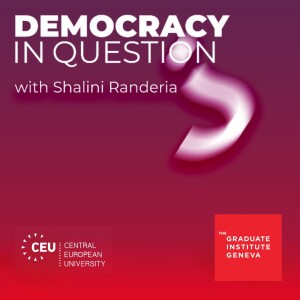
Nadia Urbinati on the Resurgence of Populism, its History, and its Various Forms
 2022-10-12
2022-10-12
Guests featured in this episode:
Nadia Urbinati, the Kyriakos Tsakopoulos Professor of Political Theory at Columbia University. She is also a permanent visiting professor at the Scuola Superiore Sant’Anna in Pisa (Italy), and has taught at Bocconi University Milan (Italy), Sciences Po Paris (France) and the UNICAMP University (Brazil). Her main fields of expertise are modern and contemporary political thought and the democratic, as well as anti-democratic traditions.
GLOSSARY
What is the People’s Party?
(13:05 or p.4 in the transcript)
The People's Party: (also known as the Populist Party) was an important political party in the United States of America during the late nineteenth century. The People's Party originated in the early 1890s. It was organized in Kansas, but the party quickly spread across the United States. It drew its members from Farmers' Alliances, the Grange, and the Knights of Labor. Originally, the Populists did not form a national organization, preferring to gain political influence within individual states. The Populist Party consisted primarily of farmers unhappy with the Democratic and Republican Parties. The Populists believed that the federal government needed to play a more active role in the American economy by regulating various businesses, especially the railroads. In particular, the Populists supported women's suffrage the direct election of United States Senators. They hoped that the enactment women's suffrage and the direct election of senators would enable them to elect some of their members to political office. Populists also supported a graduated income tax, government ownership of the railroads, improved working conditions in factories, immigration restrictions, an eight-hour workday, the recognition of unions, and easier access to credit. source
What is the Reconstruction?
(13:10 or p.4 in the transcript)
Reconstruction: in U.S. history, the period (1865–77) that followed the American Civil War and during which attempts were made to redress the inequities of slavery and its political, social, and economic legacy and to solve the problems arising from the readmission to the Union of the 11 states that had seceded at or before the outbreak of war. Long portrayed by many historians as a time when vindictiveRadical Republicans fastened Black supremacy upon the defeated Confederacy, Reconstruction has since the late 20th century been viewed more sympathetically as a laudable experiment in interracial democracy. Reconstruction witnessed far-reaching changes in America’s political life. At the national level, new laws and constitutionalamendments permanently altered the federal system and the definition of American citizenship. In the South, a politically mobilized Black community joined with white allies to bring the Republican Party to power, and with it a redefinition of the responsibilities of government. source
What is austerity?
(16:23 or p.4 in the transcript)
Austerity: (also called austerity measures) is a set of economic policies, usually consisting of tax increases, spending cuts, or a combination of the two, used by governments to reduce budget deficits. Austerity measures can in principle be used at any time when there is concern about government expenditures exceeding government revenues. Often, however, governments delay resorting to such measures because they are usually politically unpopular. Instead, governments tend to rely on other means—for example, deficit financing, which involves borrowing from financial markets—to mitigate budget deficits in the short run, a decision that usually necessitates the adoption of harsher austerity measures in the long run. source
What is universal suffrage?
(18:32 or p.5 in the transcript)
Universal suffrage: generally understood as the right to vote for political representatives conferred to almost all adult citizens or residents, regardless of their social status, property, knowledge, religion, race, gender, or other similar qualifications. The principle of universal suffrage, together with principles of equal, free, secret, and direct suffrage, present fundamental principles of elections common to all democracies around the world. Universal suffrage is one of two historically developed concepts of the suffrage—consisting of the right to vote and the right to stand for election. The other one, a concept contrary to universal suffrage, can be denominated as so-called limited suffrage. The concept of limited suffrage, preferred until the nineteenth century, was based on the exclusion of a large number of people from the suffrage. It was done based on social status, property, knowledge, religion, race, or gender. source
Democracy in Question? is brought to you by:
• Central European University: CEU
• The Albert Hirschman Centre on Democracy in Geneva: AHCD
• The Podcast Company: Novel
Follow us on social media!
• Central European University: @CEU
• Albert Hirschman Centre on Democracy in Geneva: @AHDCentre
Subscribe to the show. If you enjoyed what you listened to, you can support us by leaving a review and sharing our podcast in your networks!
More Episodes
 2022-06-22
2022-06-22
 2022-04-13
2022-04-13
 2022-03-30
2022-03-30
 2022-03-16
2022-03-16
 2022-03-02
2022-03-02
 2022-02-09
2022-02-09
Create your
podcast in
minutes
- Full-featured podcast site
- Unlimited storage and bandwidth
- Comprehensive podcast stats
- Distribute to Apple Podcasts, Spotify, and more
- Make money with your podcast
It is Free
- Privacy Policy
- Cookie Policy
- Terms of Use
- Consent Preferences
- Copyright © 2015-2024 Podbean.com




